Microeconomics: Analysis of Trade Wars and Economic Theories Impact
VerifiedAdded on 2023/05/27
|6
|1364
|279
Essay
AI Summary
This essay provides a microeconomic analysis of the trade policies enacted by President Donald Trump, particularly focusing on the trade relationship between the United States and China. It discusses the potential economic impacts of protectionist measures, such as tariffs, on both nations, including the risk of a trade war and the implications for American consumers and businesses. The essay also links these real-world scenarios to relevant economic theories like mercantilism, examining how these theories explain the motivations and consequences of trade policies. Furthermore, it details the recent history of trade tensions between the U.S. and China, highlighting specific tariffs imposed and retaliatory measures taken by both countries. The analysis emphasizes the strategic rivalry between the two nations as they compete for market share in international trade, while also considering the implications for industries and consumers.
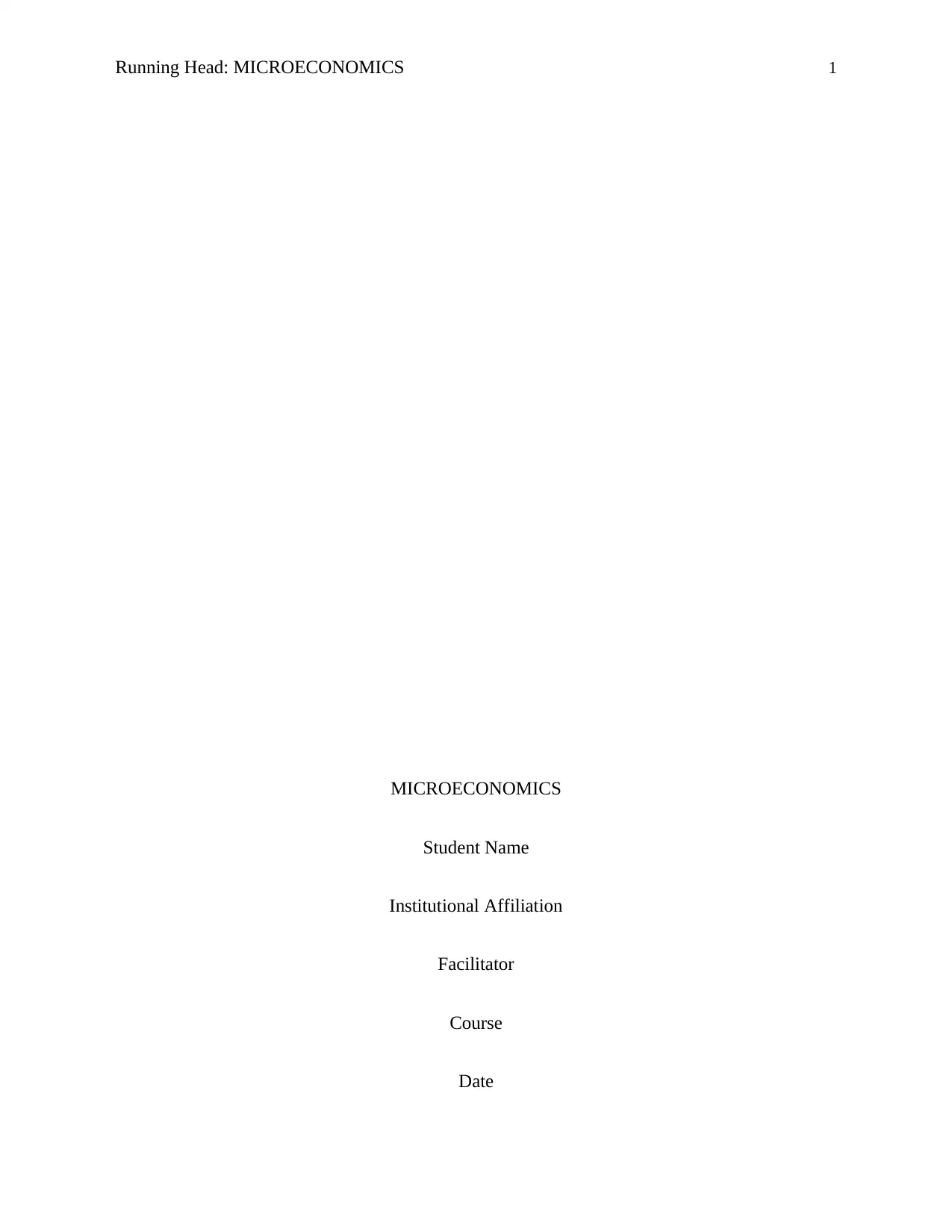
Running Head: MICROECONOMICS 1
MICROECONOMICS
Student Name
Institutional Affiliation
Facilitator
Course
Date
MICROECONOMICS
Student Name
Institutional Affiliation
Facilitator
Course
Date
Paraphrase This Document
Need a fresh take? Get an instant paraphrase of this document with our AI Paraphraser
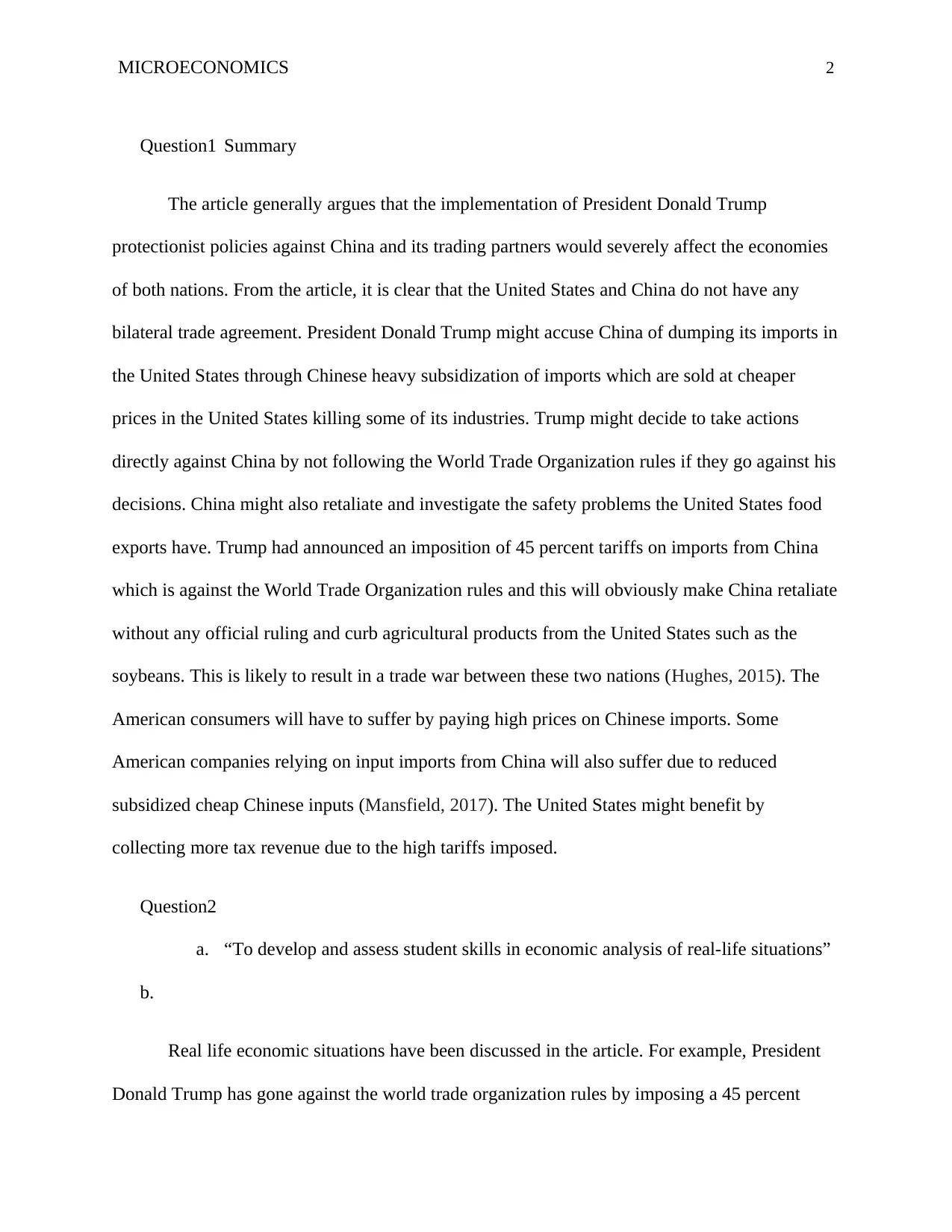
MICROECONOMICS 2
Question1 Summary
The article generally argues that the implementation of President Donald Trump
protectionist policies against China and its trading partners would severely affect the economies
of both nations. From the article, it is clear that the United States and China do not have any
bilateral trade agreement. President Donald Trump might accuse China of dumping its imports in
the United States through Chinese heavy subsidization of imports which are sold at cheaper
prices in the United States killing some of its industries. Trump might decide to take actions
directly against China by not following the World Trade Organization rules if they go against his
decisions. China might also retaliate and investigate the safety problems the United States food
exports have. Trump had announced an imposition of 45 percent tariffs on imports from China
which is against the World Trade Organization rules and this will obviously make China retaliate
without any official ruling and curb agricultural products from the United States such as the
soybeans. This is likely to result in a trade war between these two nations (Hughes, 2015). The
American consumers will have to suffer by paying high prices on Chinese imports. Some
American companies relying on input imports from China will also suffer due to reduced
subsidized cheap Chinese inputs (Mansfield, 2017). The United States might benefit by
collecting more tax revenue due to the high tariffs imposed.
Question2
a. “To develop and assess student skills in economic analysis of real-life situations”
b.
Real life economic situations have been discussed in the article. For example, President
Donald Trump has gone against the world trade organization rules by imposing a 45 percent
Question1 Summary
The article generally argues that the implementation of President Donald Trump
protectionist policies against China and its trading partners would severely affect the economies
of both nations. From the article, it is clear that the United States and China do not have any
bilateral trade agreement. President Donald Trump might accuse China of dumping its imports in
the United States through Chinese heavy subsidization of imports which are sold at cheaper
prices in the United States killing some of its industries. Trump might decide to take actions
directly against China by not following the World Trade Organization rules if they go against his
decisions. China might also retaliate and investigate the safety problems the United States food
exports have. Trump had announced an imposition of 45 percent tariffs on imports from China
which is against the World Trade Organization rules and this will obviously make China retaliate
without any official ruling and curb agricultural products from the United States such as the
soybeans. This is likely to result in a trade war between these two nations (Hughes, 2015). The
American consumers will have to suffer by paying high prices on Chinese imports. Some
American companies relying on input imports from China will also suffer due to reduced
subsidized cheap Chinese inputs (Mansfield, 2017). The United States might benefit by
collecting more tax revenue due to the high tariffs imposed.
Question2
a. “To develop and assess student skills in economic analysis of real-life situations”
b.
Real life economic situations have been discussed in the article. For example, President
Donald Trump has gone against the world trade organization rules by imposing a 45 percent
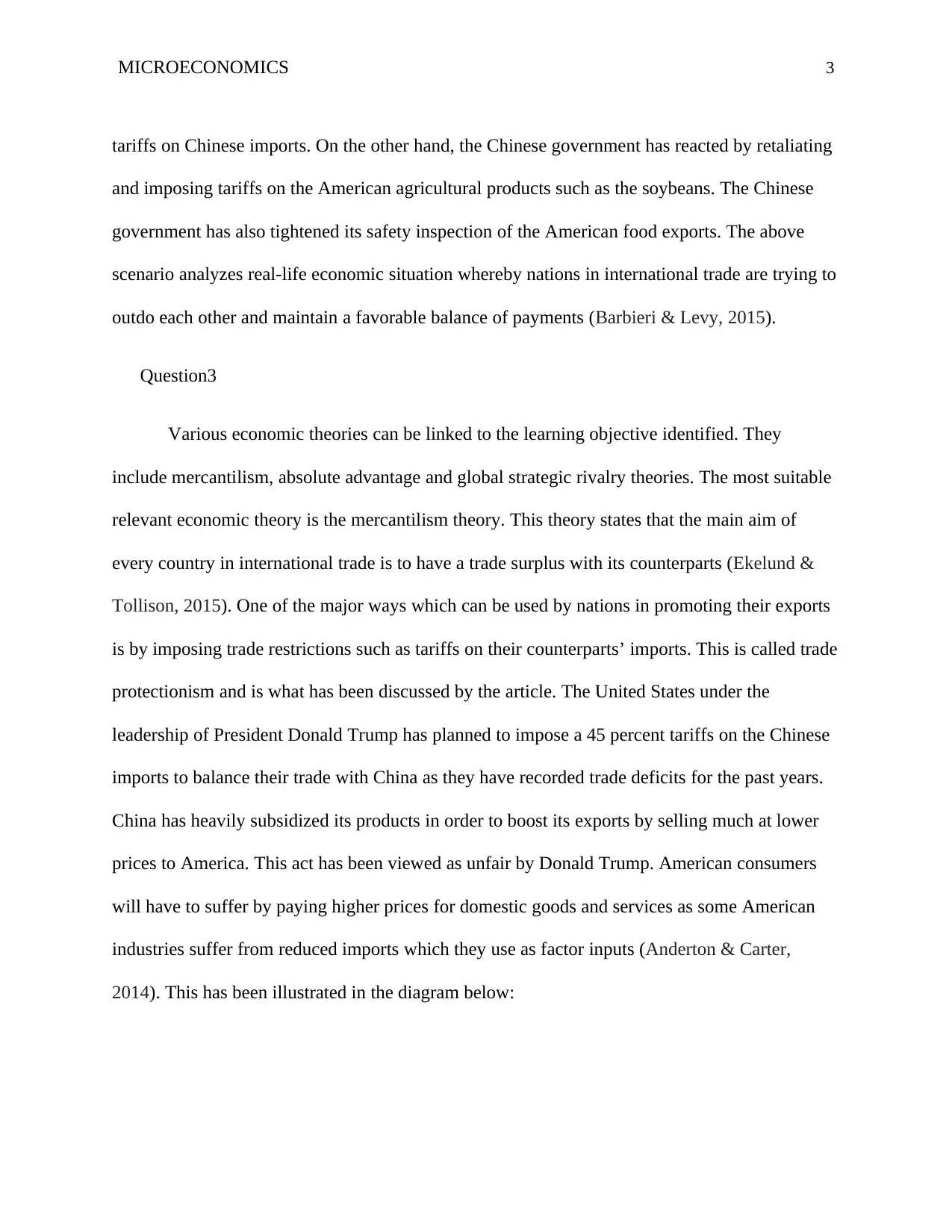
MICROECONOMICS 3
tariffs on Chinese imports. On the other hand, the Chinese government has reacted by retaliating
and imposing tariffs on the American agricultural products such as the soybeans. The Chinese
government has also tightened its safety inspection of the American food exports. The above
scenario analyzes real-life economic situation whereby nations in international trade are trying to
outdo each other and maintain a favorable balance of payments (Barbieri & Levy, 2015).
Question3
Various economic theories can be linked to the learning objective identified. They
include mercantilism, absolute advantage and global strategic rivalry theories. The most suitable
relevant economic theory is the mercantilism theory. This theory states that the main aim of
every country in international trade is to have a trade surplus with its counterparts (Ekelund &
Tollison, 2015). One of the major ways which can be used by nations in promoting their exports
is by imposing trade restrictions such as tariffs on their counterparts’ imports. This is called trade
protectionism and is what has been discussed by the article. The United States under the
leadership of President Donald Trump has planned to impose a 45 percent tariffs on the Chinese
imports to balance their trade with China as they have recorded trade deficits for the past years.
China has heavily subsidized its products in order to boost its exports by selling much at lower
prices to America. This act has been viewed as unfair by Donald Trump. American consumers
will have to suffer by paying higher prices for domestic goods and services as some American
industries suffer from reduced imports which they use as factor inputs (Anderton & Carter,
2014). This has been illustrated in the diagram below:
tariffs on Chinese imports. On the other hand, the Chinese government has reacted by retaliating
and imposing tariffs on the American agricultural products such as the soybeans. The Chinese
government has also tightened its safety inspection of the American food exports. The above
scenario analyzes real-life economic situation whereby nations in international trade are trying to
outdo each other and maintain a favorable balance of payments (Barbieri & Levy, 2015).
Question3
Various economic theories can be linked to the learning objective identified. They
include mercantilism, absolute advantage and global strategic rivalry theories. The most suitable
relevant economic theory is the mercantilism theory. This theory states that the main aim of
every country in international trade is to have a trade surplus with its counterparts (Ekelund &
Tollison, 2015). One of the major ways which can be used by nations in promoting their exports
is by imposing trade restrictions such as tariffs on their counterparts’ imports. This is called trade
protectionism and is what has been discussed by the article. The United States under the
leadership of President Donald Trump has planned to impose a 45 percent tariffs on the Chinese
imports to balance their trade with China as they have recorded trade deficits for the past years.
China has heavily subsidized its products in order to boost its exports by selling much at lower
prices to America. This act has been viewed as unfair by Donald Trump. American consumers
will have to suffer by paying higher prices for domestic goods and services as some American
industries suffer from reduced imports which they use as factor inputs (Anderton & Carter,
2014). This has been illustrated in the diagram below:
⊘ This is a preview!⊘
Do you want full access?
Subscribe today to unlock all pages.

Trusted by 1+ million students worldwide
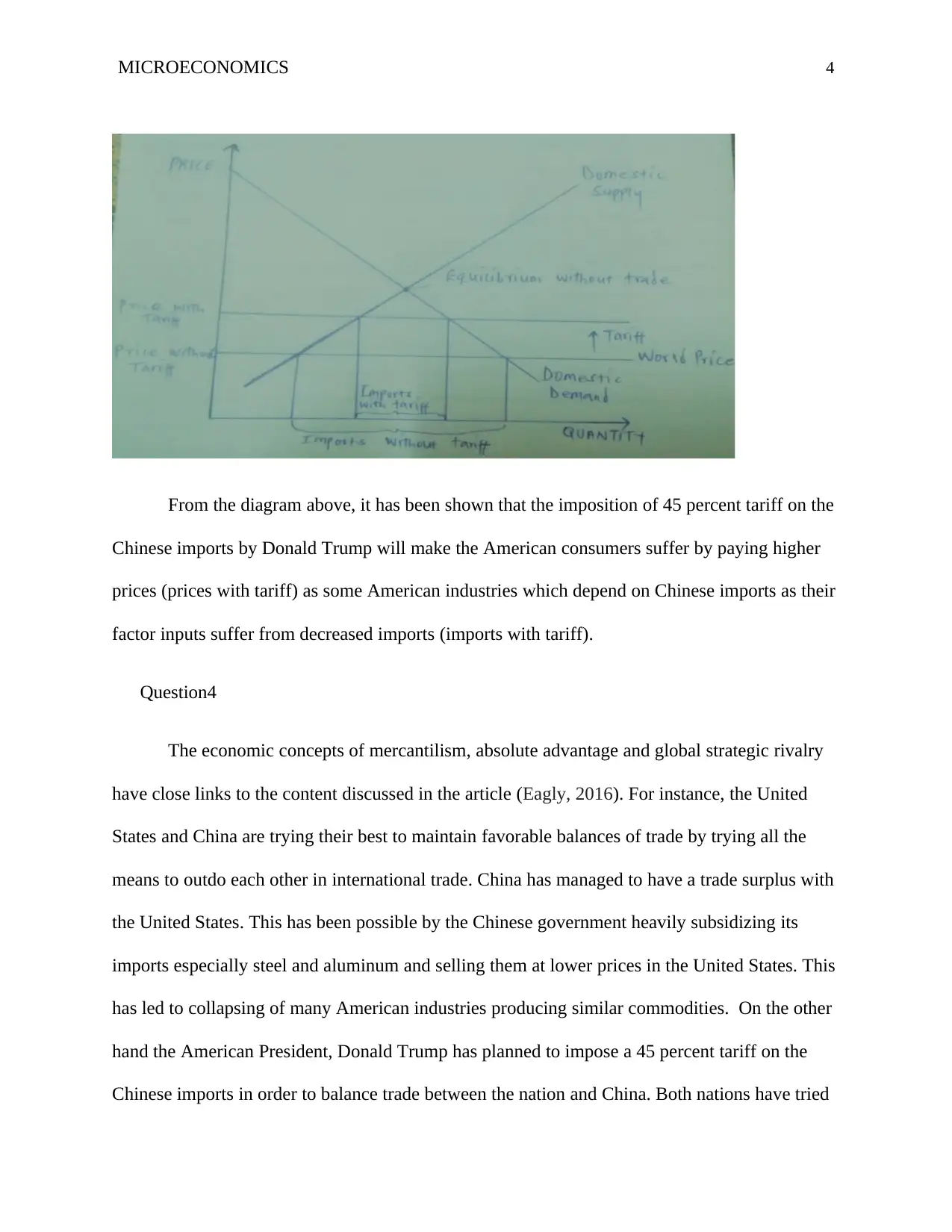
MICROECONOMICS 4
From the diagram above, it has been shown that the imposition of 45 percent tariff on the
Chinese imports by Donald Trump will make the American consumers suffer by paying higher
prices (prices with tariff) as some American industries which depend on Chinese imports as their
factor inputs suffer from decreased imports (imports with tariff).
Question4
The economic concepts of mercantilism, absolute advantage and global strategic rivalry
have close links to the content discussed in the article (Eagly, 2016). For instance, the United
States and China are trying their best to maintain favorable balances of trade by trying all the
means to outdo each other in international trade. China has managed to have a trade surplus with
the United States. This has been possible by the Chinese government heavily subsidizing its
imports especially steel and aluminum and selling them at lower prices in the United States. This
has led to collapsing of many American industries producing similar commodities. On the other
hand the American President, Donald Trump has planned to impose a 45 percent tariff on the
Chinese imports in order to balance trade between the nation and China. Both nations have tried
From the diagram above, it has been shown that the imposition of 45 percent tariff on the
Chinese imports by Donald Trump will make the American consumers suffer by paying higher
prices (prices with tariff) as some American industries which depend on Chinese imports as their
factor inputs suffer from decreased imports (imports with tariff).
Question4
The economic concepts of mercantilism, absolute advantage and global strategic rivalry
have close links to the content discussed in the article (Eagly, 2016). For instance, the United
States and China are trying their best to maintain favorable balances of trade by trying all the
means to outdo each other in international trade. China has managed to have a trade surplus with
the United States. This has been possible by the Chinese government heavily subsidizing its
imports especially steel and aluminum and selling them at lower prices in the United States. This
has led to collapsing of many American industries producing similar commodities. On the other
hand the American President, Donald Trump has planned to impose a 45 percent tariff on the
Chinese imports in order to balance trade between the nation and China. Both nations have tried
Paraphrase This Document
Need a fresh take? Get an instant paraphrase of this document with our AI Paraphraser
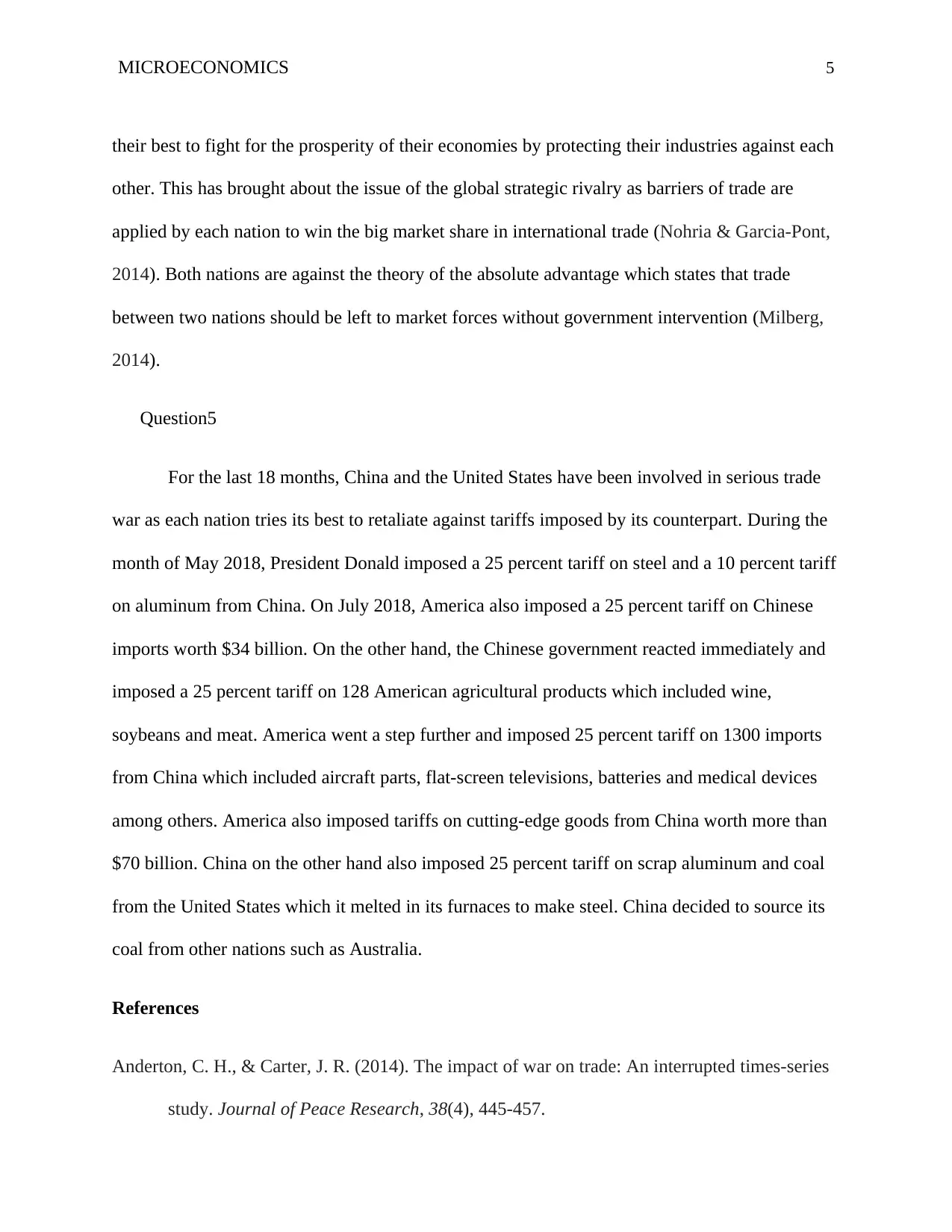
MICROECONOMICS 5
their best to fight for the prosperity of their economies by protecting their industries against each
other. This has brought about the issue of the global strategic rivalry as barriers of trade are
applied by each nation to win the big market share in international trade (Nohria & Garcia‐Pont,
2014). Both nations are against the theory of the absolute advantage which states that trade
between two nations should be left to market forces without government intervention (Milberg,
2014).
Question5
For the last 18 months, China and the United States have been involved in serious trade
war as each nation tries its best to retaliate against tariffs imposed by its counterpart. During the
month of May 2018, President Donald imposed a 25 percent tariff on steel and a 10 percent tariff
on aluminum from China. On July 2018, America also imposed a 25 percent tariff on Chinese
imports worth $34 billion. On the other hand, the Chinese government reacted immediately and
imposed a 25 percent tariff on 128 American agricultural products which included wine,
soybeans and meat. America went a step further and imposed 25 percent tariff on 1300 imports
from China which included aircraft parts, flat-screen televisions, batteries and medical devices
among others. America also imposed tariffs on cutting-edge goods from China worth more than
$70 billion. China on the other hand also imposed 25 percent tariff on scrap aluminum and coal
from the United States which it melted in its furnaces to make steel. China decided to source its
coal from other nations such as Australia.
References
Anderton, C. H., & Carter, J. R. (2014). The impact of war on trade: An interrupted times-series
study. Journal of Peace Research, 38(4), 445-457.
their best to fight for the prosperity of their economies by protecting their industries against each
other. This has brought about the issue of the global strategic rivalry as barriers of trade are
applied by each nation to win the big market share in international trade (Nohria & Garcia‐Pont,
2014). Both nations are against the theory of the absolute advantage which states that trade
between two nations should be left to market forces without government intervention (Milberg,
2014).
Question5
For the last 18 months, China and the United States have been involved in serious trade
war as each nation tries its best to retaliate against tariffs imposed by its counterpart. During the
month of May 2018, President Donald imposed a 25 percent tariff on steel and a 10 percent tariff
on aluminum from China. On July 2018, America also imposed a 25 percent tariff on Chinese
imports worth $34 billion. On the other hand, the Chinese government reacted immediately and
imposed a 25 percent tariff on 128 American agricultural products which included wine,
soybeans and meat. America went a step further and imposed 25 percent tariff on 1300 imports
from China which included aircraft parts, flat-screen televisions, batteries and medical devices
among others. America also imposed tariffs on cutting-edge goods from China worth more than
$70 billion. China on the other hand also imposed 25 percent tariff on scrap aluminum and coal
from the United States which it melted in its furnaces to make steel. China decided to source its
coal from other nations such as Australia.
References
Anderton, C. H., & Carter, J. R. (2014). The impact of war on trade: An interrupted times-series
study. Journal of Peace Research, 38(4), 445-457.
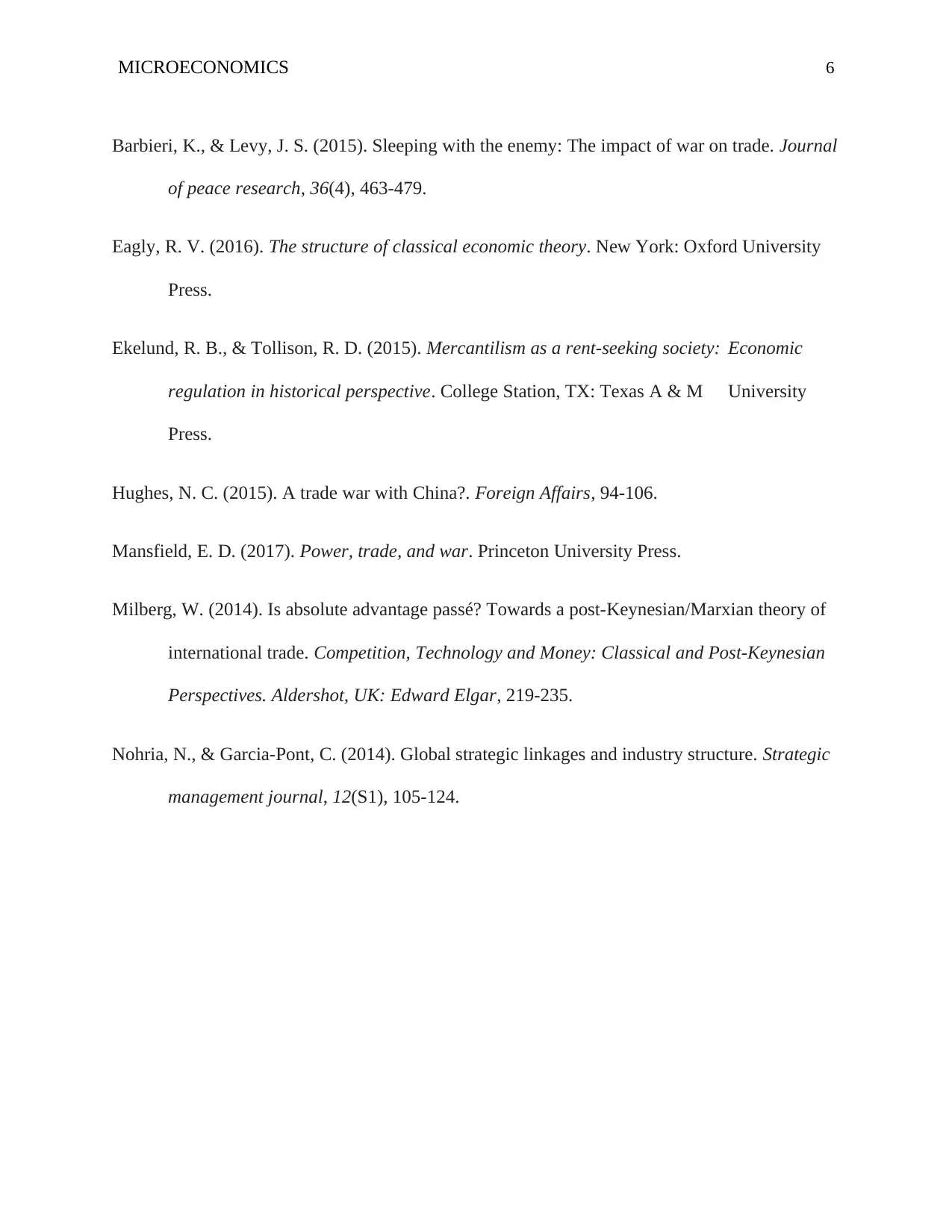
MICROECONOMICS 6
Barbieri, K., & Levy, J. S. (2015). Sleeping with the enemy: The impact of war on trade. Journal
of peace research, 36(4), 463-479.
Eagly, R. V. (2016). The structure of classical economic theory. New York: Oxford University
Press.
Ekelund, R. B., & Tollison, R. D. (2015). Mercantilism as a rent-seeking society: Economic
regulation in historical perspective. College Station, TX: Texas A & M University
Press.
Hughes, N. C. (2015). A trade war with China?. Foreign Affairs, 94-106.
Mansfield, E. D. (2017). Power, trade, and war. Princeton University Press.
Milberg, W. (2014). Is absolute advantage passé? Towards a post-Keynesian/Marxian theory of
international trade. Competition, Technology and Money: Classical and Post-Keynesian
Perspectives. Aldershot, UK: Edward Elgar, 219-235.
Nohria, N., & Garcia‐Pont, C. (2014). Global strategic linkages and industry structure. Strategic
management journal, 12(S1), 105-124.
Barbieri, K., & Levy, J. S. (2015). Sleeping with the enemy: The impact of war on trade. Journal
of peace research, 36(4), 463-479.
Eagly, R. V. (2016). The structure of classical economic theory. New York: Oxford University
Press.
Ekelund, R. B., & Tollison, R. D. (2015). Mercantilism as a rent-seeking society: Economic
regulation in historical perspective. College Station, TX: Texas A & M University
Press.
Hughes, N. C. (2015). A trade war with China?. Foreign Affairs, 94-106.
Mansfield, E. D. (2017). Power, trade, and war. Princeton University Press.
Milberg, W. (2014). Is absolute advantage passé? Towards a post-Keynesian/Marxian theory of
international trade. Competition, Technology and Money: Classical and Post-Keynesian
Perspectives. Aldershot, UK: Edward Elgar, 219-235.
Nohria, N., & Garcia‐Pont, C. (2014). Global strategic linkages and industry structure. Strategic
management journal, 12(S1), 105-124.
⊘ This is a preview!⊘
Do you want full access?
Subscribe today to unlock all pages.

Trusted by 1+ million students worldwide
1 out of 6
Related Documents
Your All-in-One AI-Powered Toolkit for Academic Success.
+13062052269
info@desklib.com
Available 24*7 on WhatsApp / Email
![[object Object]](/_next/static/media/star-bottom.7253800d.svg)
Unlock your academic potential
Copyright © 2020–2025 A2Z Services. All Rights Reserved. Developed and managed by ZUCOL.





